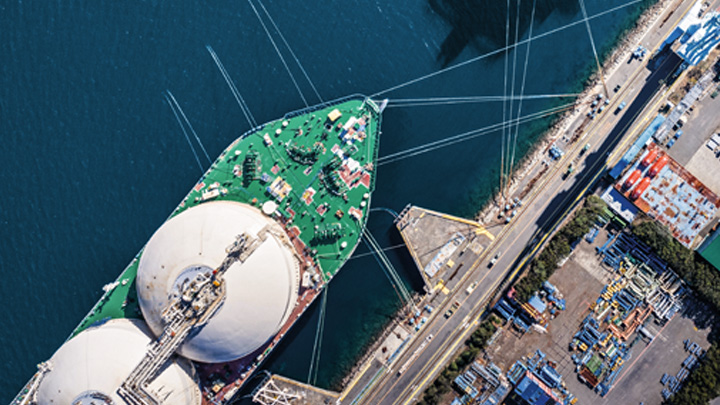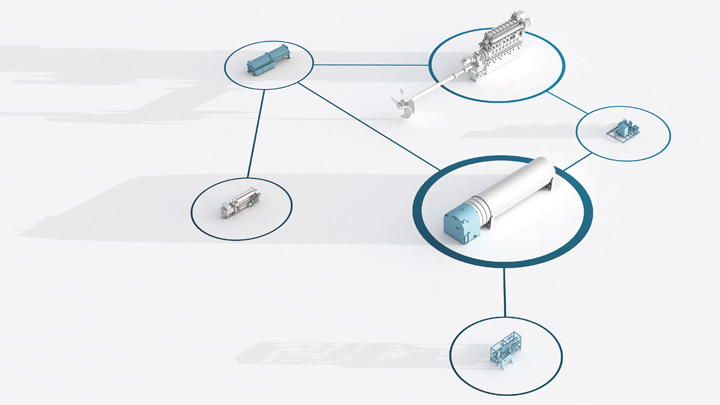Cryogenic solutions for marine and onshore applications
Future fuels have the potential to answer the demand for clean energy, but some fuels require cryogenic (low temperature) handling. MAN Cryo is a leading provider of engineering solutions for cryogenic applications as well as for alternative fuels, such as ammonia and methanol.
Pioneers in cryogenic fuel handling and decarbonization
For more than 60 years, MAN Cryo has set industry milestones in new cryogenic technology, such as the first LNG-fueled ship. At the same time, we are known for reliable, robust and high-quality equipment and profound engineering know-how.
Our experienced staff is supported by MAN PrimeServ - our worldwide service network. Our strategy is straightforward yet impactful: We deliver premium service with dedication to fulfill each customer's unique requirements. We select top-tier professionals, equip them with the necessary skills, prioritize customer feedback, and ensure optimal flexibility and reliability in the services we provide.
This makes us excellent partners in the development of new solutions for the energy transition and decarbonization.
Engineering cryogenic solutions for the energy transition
Unlock the full potential of your ships and power plants with our tailored engineering solutions designed for LNG, hydrogen, LH2, methanol and ammonia operations. Our comprehensive range of services includes expert design, meticulous quality assurance, efficient project management, and seamless commissioning. Rest assured, our products are certified to meet the highest industry standards, including ISO 9001, ISO 14001, OHSAS 18001, and ISO 3834-2. Partner with us to revolutionize your maritime and energy infrastructure.
Efficient and economical cryogenic equipment
MAN Cryo can count the first LNG-bunkering vessel in the world and the first LNG terminals in Sweden among its many achievements. Together with MAN’s engine and GenSet expertise, we can offer engineering solutions for comprehensive engine and LNG fuel gas supply systems.
We offer engineering of:
- H2 fuel gas supply systems
- Ammonia fuel supply systems
- Methanol supply systems
- LNG fuel gas supply systems
- Power plants
- Onshore and offshore bunkering systems
- Regasification systems
- Power-to-X
- Engineering of green H2 production plants, storage and distributiion


Benefits at a glance
- Holistic approach and seamless compatibility with MAN dual fuel engines
- Clean burning gas, reduced NOX, CO2, particles and SOX emissions
- Increased fuel efficiency
- Lower operating costs
- Flexibility and fuel independence
- One point of contact for all components, training and support
MAN Cryo – engineering solutions for cryogenic applications and alternative fuels
Learn more about MAN Cryo, its transition for being a turnkey supplier for LNG supply systems to an engineering provider, and how alternative fuels have become a vital part of its core business. Watch Reinert Magnusson, Head of MAN Cryo for insights into marine and on-shore solutions supporting customers on their decarbonization journey.
Unlock the power of cryogenic solutions
Contact us
Your one-stop source for energy transition solutions
MAN Cryo is your trusted partner when it comes to efficient and economical cryogenic equipment for the most demanding applications.
Contact us to stay cool under pressure.
Frequently asked questions
What is cryogenic equipment, and how does it work?
Cryogenic equipment refers to specialized machinery designed to handle extremely low temperatures, typically below -150°C. It is crucial for the storage, transportation, and processing of materials such as liquefied natural gas (LNG), hydrogen, and other cryogenic substances. The process involves creating an environment that maintains these substances in their cryogenic state, allowing for safe storage, transfer, and use.
How does cryogenic transportation differ from traditional shipping methods?
Cryogenic shipping differs significantly from traditional transportation methods because of extremely low temperatures. Unlike standard shipping, which deals with materials at regular temperatures, cryogenic transportation involves the movement of substances in a cryogenic state. Special containers, known as cryogenic tanks, are used to maintain the low temperatures and high pressure required for materials like LNG or liquid nitrogen. The vessels, insulation, and safety protocols are tailored to handle these extreme conditions, ensuring the integrity of the transported cryogenic materials.
How does cryogenic equipment contribute to clean energy solutions?
Cryogenic equipment plays a crucial role in advancing clean energy solutions by facilitating the storage, transportation, and utilization of alternative fuels. LNG, when used as a fuel, produces lower emissions of greenhouse gases, contributing to reduced environmental impact. In addition, the cryogenic storage of hydrogen is efficiently used in fuel cells for various applications, promoting a more sustainable energy landscape.
In which industries is cryogenic equipment integrated?
Cryogenic equipment is seamlessly integrated into diverse industrial processes across sectors such as manufacturing, food processing, and healthcare. MAN Energy Solutions offers cryogenic solutions for marine and onshore projects
Related news
Shipbuilding Projects with Ammonia Engines Firm Up
Imabari Shipbuilding will install an MAN B&W 7S60ME-Ammonia engine with SCR in connection with the construction of a 200,000 dwt class bulk carrier for a joint venture between K Line, NS United and Itochu Corporation. The business represents one of the first projects for MAN Energy Solutions’ ammonia-powered engine that is currently under development in Denmark. MITSUI E&S will build the engine in Japan.
Brian Østergaard Sørensen, Vice President and Head of Research & Development, Two-Stroke at MAN Energy Solutions, said: “This project marks another important milestone in our ammonia-engine development and indeed for the maritime industry in general. It also confirms that we are on the right track in relation to our dual-fuel ammonia concept where we have gained a great understanding of ammonia’s unique characteristics as a marine fuel via our two-stroke engine testing, which we started in early June 2023. Equally as important, we are confident of how to handle it safely; it is very satisfying to see our hard work beginning to pay off.”
Bjarne Foldager – Country Manager, Denmark – MAN Energy Solutions, said: “The interest in this revolutionary engine had been overwhelming, even prior to our two-stroke ammonia-engine testing, but has even intensified after the important lessons learnt from ammonia-combustion testing on the test engine here in Copenhagen. While the current growth in shipping will increase greenhouse-gas emissions, alternative fuels like e-methanol, e-methane and green ammonia will eventually come to compete with fossil fuels but we need regulation to encourage their adoption in the industry. Regulatory clarity from the EU and IMO is improving but now we need the right market-based tools to be introduced in order to bring the industry towards carbon neutrality for 2050.”
Thomas S. Hansen, Head of Sales and Promotion, MAN Energy Solutions, said: “MAN Energy Solutions has developed this engine since 2019 with over 100,000 man-hours recorded in that time. This first MAN B&W ammonia engine is a 60-bore type, which is applicable to a broad range of vessel segments. We believe that the success of ammonia as a marine fuel strongly relies on a safe introduction to the market. We will therefore monitor a number of engines entering operation at sea to ensure that the engine design and functionality of the auxiliary systems meet our expectations before the engine is formally introduced to our marine-engine programme as part of a full sales release. In the short term, we expect a fast uptake of ammonia-fuelled engines towards the end of the decade as we obtain positive seagoing experience from the first engines. In the long term, we expect ammonia to comprise around 35% of fuel used onboard large merchant-marine vessels by 2050 due to lower production cost compared to other e-fuels relevant for large merchant-marine vessels.”
Documents
-
PR First Ammonia Engine_EN
Contact
Nils Søholt
Trade Press Marine
Group Communications & MarktingEverllenceTeglholmsgade 412450 Copenhagen SVDenmark
nils.soeholt@everllence.com t +45 33 85 26 69Available languages
- DE ·
- EN
Get notified about press releases
Continue reading
MAN Energy Solutions is now Everllence.
We have adopted a new brand name and moved to a new domain: www.everllence.com. This page will also be relocated there shortly. We are working on shifting all pages to www.everllence.com.
